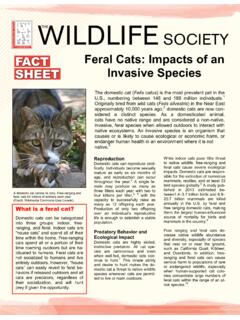Transcription of Language and Gender - University of Chicago
1 Language and Gender First, some claims 1) Men interrupt women more than vice versa. 2) Women are more communicative than men. 3) Men do not give verbal recognition of the contributions in the conversation made by women. 4) Men curse more than women. 5) Women gossip more than men. 6) Women talk more with one another than men do. 7) Men speak more comfortably in public than women. Two subtopics Topic 1: The representation of Gender in Language Topic 2: The conversational characteristics of men and women Gender and sex Sex: a biological condition, defined as a set of physical characteristics Gender : a social construct (within the fields of cultural and Gender studies, and the social sciences "Today a return to separate single-sex schools may hasten the revival of separate Gender roles".
2 Wendy Kaminer, in The Atlantic Monthly (1998). General usage of the term Gender began in the late 1960s and 1970s, increasingly appearing in the professional literature of the social sciences. The term helps in distinguishing those aspects of life that were more easily attributed or understood to be of social rather than biological origin (see , Unger & Crawford, 1992). Linguistic origins of Gender According to Aristotle, the Greek philosopher Protagoras used the terms masculine, feminine, and neuter to classify nouns, introducing the concept of grammatical Gender . Gender as a grammatical category Many languages specify Gender (and Gender agreement). (1) Greek o andras i gyneka to pedhi man woman child (2) German der man die Frau das Kind man woman child (3) French l(e) homme la femme man woman Indoeuropean had Gender distinction; Swahili has 16 Gender distinctions And many others don't!
3 English, Astronesian languages But Gender appears on pronouns: (1) He left. (2) She left. (3) It left. (what types of things does it refer to?). Gender correlates with other perceptual (and possibly grammatical). categories like humaness, agentivity, and animacy. (4) The boy broke the vase. It was naughty. (5) Das M dchen hat den Vase gebrochen. {Sie/Es} war unanst ndlich. Does Gender influence our perception of categories? Some may think that it does! Borodisky, Schmit, and Phillips (2002): German versus Spanish Gender oosative versus soupative distinction in Gumpuzi The question must be understood within the context of whether Language influences thought (the Sapir-Whorf hypothesis). The Whorfian Hypothesis We dissect nature along lines laid by our own Language .
4 [ ] the world is presented as a kaleidoscope flux of impressions which has to be organized by our minds and this means largely by the linguistic systems in our minds.. (Benjamin Lee Whorf, 1956: Language , Thought, and Reality. MIT Press, Cambridge MA.). Back to Gender The Awful German Language , by Mark Twain Surely there is not another Language that is so slipshod and systemless, and so slippery and elusive to the grasp. [..] To continue with the German genders: a tree is male, its buds are female, its leaves are neuter; horses are sexless, dogs are male, cats are female -- tomcats included, of course; a person's mouth, neck, bosom, elbows, fingers, nails, feet, and body are of the male sex, and his head is male or neuter according to the word selected to signify it, and not according to the sex of the individual who wears it -- for in Germany all the women have either male heads or sexless ones; a person's nose, lips, shoulders, breast, hands, and toes are of the female sex; and his hair, ears, eyes, chin, legs, knees, heart, and conscience haven't any sex at all.
5 The inventor of the Language probably got what he knew about a conscience from hearsay.. I Mark Twain, continued In the German it is true that by some oversight of the inventor of the Language , a Woman is a female; but a Wife (Weib) is not -- which is unfortunate. A Wife, here, has no sex; she is neuter; so, according to the grammar, a fish is he, his scales are she, but a fishwife is neither. To describe a wife as sexless may be called under-description; that is bad enough, but over-description is surely worse. A German speaks of an Englishman as the Engl nder;. to change the sex, he adds inn, and that stands for Englishwoman -- Engl nderinn. That seems descriptive enough, but still it is not exact enough for a German; so he precedes the word with that article which indicates that the creature to follow is feminine, and writes it down thus: "die Engl nderinn," -- which means "the she- Englishwoman.
6 " I consider that that person is over-described.. Greek (1) o helios i selene the sun (masc) the moon (fem). German (2) die Sonne der Mond the sun (fem) the moon (masc). Question: Should the contrast be taken to suggest that the Germans and Greek perceive the moon and the sun differently? Answer: Not really! It seems more reasonable to believe that human conceptual structure remains constant in its core features across languages. Do Gender and sex differences affect the way people engage in conversation? The answer to this question is positive! It has to do with the way we use Language in communication. Bact to our earlier claims: Men interrupt women more than vice versa. Women are more communicative. Men do not give verbal recognition of the contributions in the conversation made by women.
7 Men curse more than women. Women gossip more than men. Women talk more with one another than men do. Men speak more comfortably in public than women Some History Language was a particular feature and target of Women's feminist movements in the 60s and 70s. The very semantics of the Language reflects [women's] condition. We do not even have our own names, but bear that of the father until we echange it for that of a husband.. (Robin Morgan (1977: 106), Going Too Far). Claim: Language is sexist! Examples chairman, spokesman, barman, generic he More sexist elements in Language that are not that innocent (1) a He is a master of the intricacies of academic politics. b She is a mistress of the intricacies . (2) a He is a professional. b She is a professional.
8 Sexual connotations in both cases (3) a Mary hopes to meet an eligible bachelor. b Bill hopes to meet an eligible spinster. Robin Lakoff: Language and the Woman's Place (1975). Sexist Language Shift to Gender differences in discource Dale Spender, 1980: Man Made Language . (UK). Differences in conversational styles actually turn out to disandvantage women, contributing to women being effectively silenced. This is the hightime of the feminist movement! Robin Lakoff: Language and the Woman's Place (1975). Our use of Language embodies attitudes as well as referential meantings. Woman's Language has its foundation the attitude that women are marginal to the serious concerns of life, which are preempted by men.. Some Characteristics of Women's Talk Marry Haas, 1944: Men's and Women's speech in Koasati, Language 20.
9 In Koasati, a Muskogean Language , men and women's speech have different phonological and morphological features. English is different. According to Lakoff, women's talk has the following properties: 1) A large set of words specific to their interests: color words like magenta, shirr, dart (in sewing), etc. 2) Empty adjectives such as divine, precious, lovely, cute, etc. 3) Tag questions and rising intonation in statement contexts: What's your name dear? Mary Smith? 4) Use of hedges 5) Use of intensive so . 6) Hypercorrect grammar: women are not supposed to talk rough 7) Super-politeness 8) Ask more questions Goal of politeness: oppression! Womens' talk is a cultural product Deborah Tannen, 1990. You Just Don't Understand: Women and Men in Conversation Women speak a Language of connection and intimacy Men speak a Language of status and independence Thus: Their communication can be like cross-cultural communication.
10 Background: interethnic communication Problems between people of different ethnic groups are the result of differences in systems of conversational inference, and the cues for signalling speech acts and speaker intend.. (Gumperz, 1978: The conversational analysis of interethnic communication). See also Maltz and Borker 1982. Premise: Women and men live in different worlds And segregation starts early! Boys and girls grow up largely in one-sex groups. Maltz and Borker, 1982: A cultural approach to male- female miscommunication. In Language and Social Identity, Cambridge University Press. Boys: Tend to play in large groups that are hierarchically structured Their group has a leader Status is negotiated via orders, or telling jokes/stories Games have winners and losers Boast about skills, size, ability Girls: Tend to play in small groups or in pairs The center of a girl's social life is a best friend Within the group, intimacy is the key Differentiation is measured not by status, but by relative closeness Many of their activities do not have winners and losers ( in hopscotch or jump rope, everyone gets a turn).







